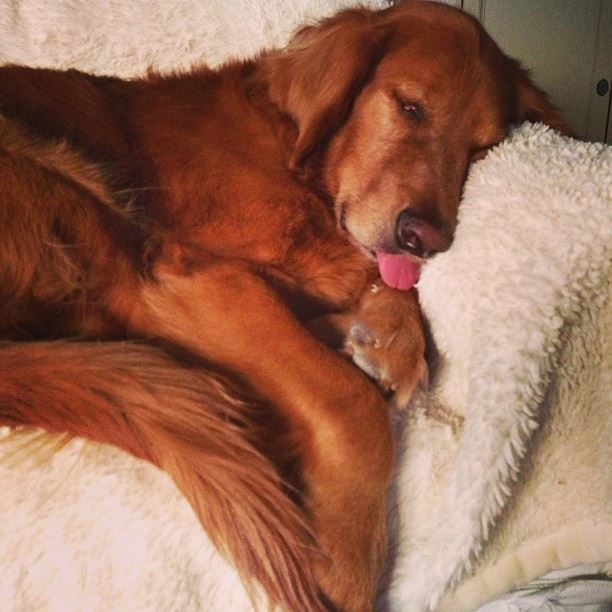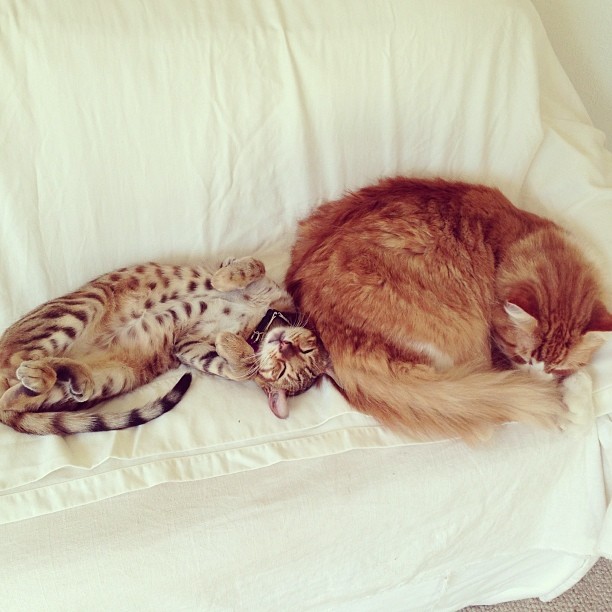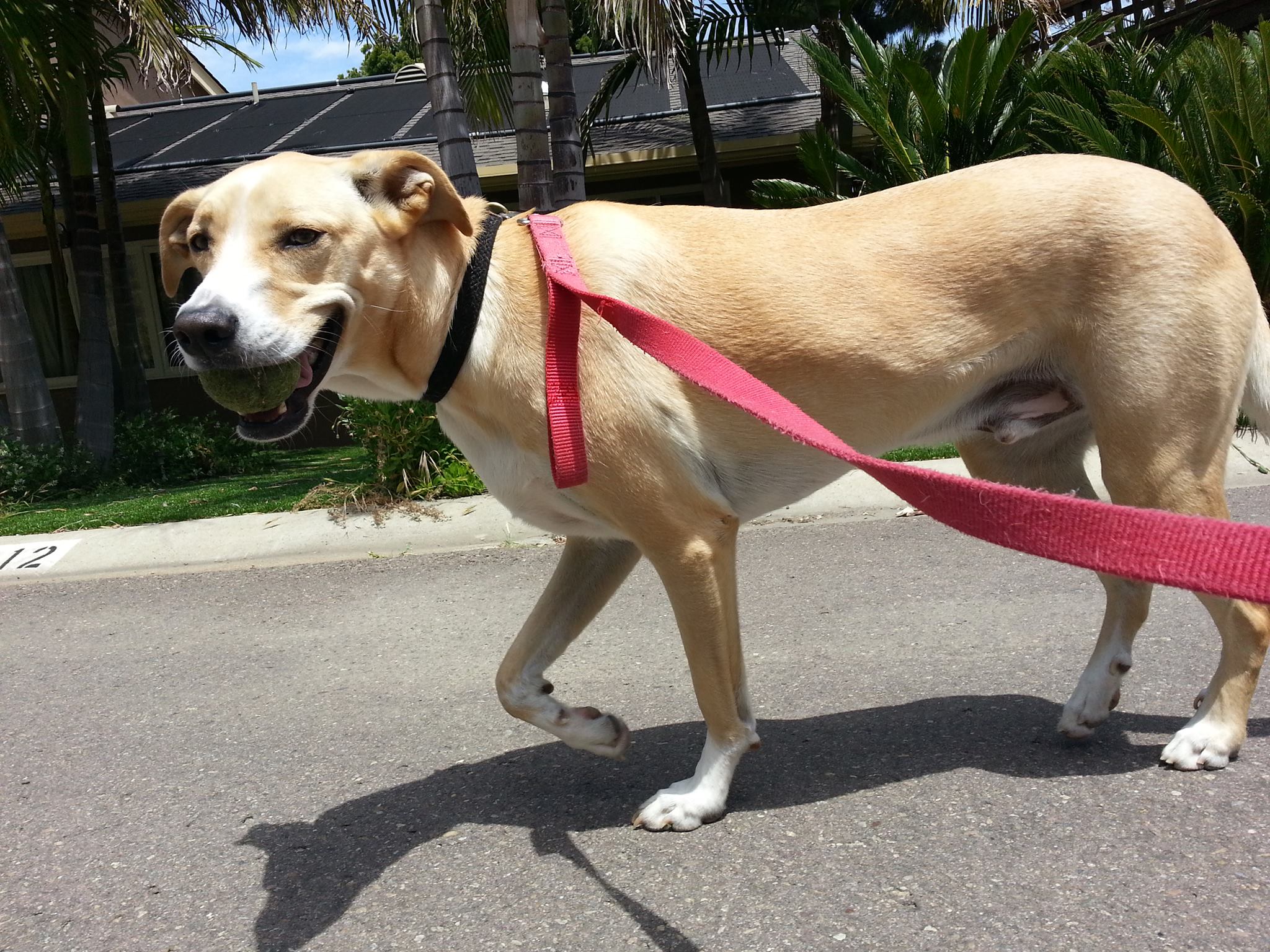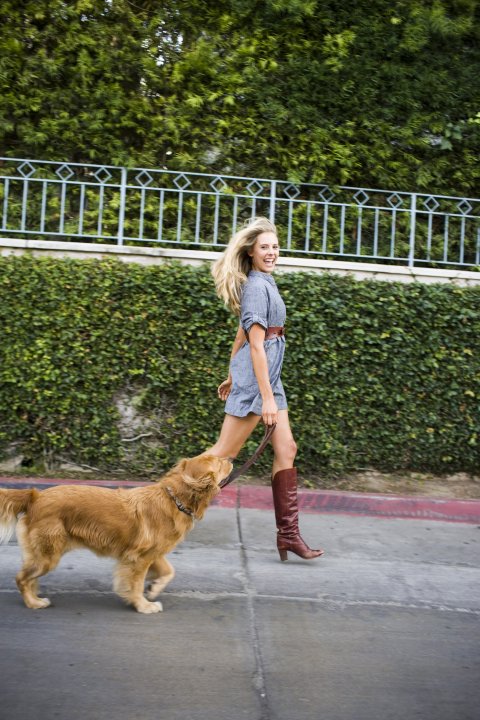Viewing entries in
The DogZenergy Method
"How much exercise does my dog need?" We get this question a lot and the answer varies by the breed, temperament and age of the dog. Take the lovable, chubby, short-nosed breeds for example. An Old English Bulldog only needs as much exercise as he can physically handle. Some bulldogs can play, run and wrestle for quite a while, but others are happy with taking a walk around a few blocks. One thing is for certain, a bulldog is never going to lap a Viszla. Viszlas, German Short-Haired Pointers, Labs, Goldens, Dobermans, German Shepherds, Malinois and other similar working breeds are made to run and well, work. These dogs can literally keep up with their handlers all day long. They've been bred to be guard dogs, bomb dogs, scent tracking dogs, service dogs, bird dogs, rescue dogs and much more. They can work all day long and they absolutely love it. Now imagine taking that job away from them and not giving them the outlet to expend their energy. It has to go somewhere. These dogs have been bred for centuries to not only be our companions and look pretty, they've also been bred to go to have the brains, stamina and function to work by their humans' sides all day long. Unfortunately, it's not realistic for all of us to take our dogs to work (although there's some awesome companies that do allow it!), so our dogs wait at home for us while we go about our days. During this time, it's like a pot of boiling water with paws, waiting for us to come through the door so they can explode with energy and excitement. I probably shouldn't say this, because as a dog trainer I'm putting myself out of work, but I'd say 80% of behavioral problems simply come from a severe lack of exercise and mental stimulation. Plain and simple- modern dogs are bored out of their minds.
Growing up, we lived on a mini ranch in Temecula with no fences and our dogs had complete freedom. They were never ever cooped up in the house and they could go on adventures wherever they pleased. They could lay in the grass in front of our house all day under the willow trees, they could eat as much horse poop as they wanted and they could gorge themselves on avocados, which became quite a problem when the avocados were ripe and falling off the trees. Let's just say they were very pleasantly plump and shiny! The dogs walked themselves and ran around when they wanted to. They were never very hyper and they hardly ever got the crazies. They didn't have any behavioral problems (except for our dog Griffey got into a chicken coop one day and helped himself to a few). When Griffey was a puppy he also had a field day with a package dropped off by UPS full of my dad's robotic parts. Other than that, the dogs could be dogs and they were the best most well behaved dogs that I've ever met. Even more well behaved than my two goldens that I share my life with now. Why? Because they were free to be happy animals outside- running, playing, sniffing, smelling and exploring. It was totally and utterly completely natural. We must remind ourselves that dogs are not born as little humans with dog coats. They're also not born with built in knowledge about how to live in a human's house with humans who are pretty darn boring sitting in front of computer and tv screens. Naturally, a dog would pee wherever they want to outside, they would run to whatever they want to smell at the moment not constrained by a leash around their neck, and they would chew on whatever stick they could find. In our human world, we require them to be so subdued in the house. We want them to just lay there or cuddle with us and look cute (I'm so guilty of this). Most dogs are inside the majority of their lives with just a few quick potty breaks and maybe an hour walk around the neighborhood to break up the day.
We need to change this. We need to get our dogs outside more and get them closer to their natural habits. They need to be outside breathing in fresh air and stimulating their minds with socialization and adventures. Back to the original question of "How much exercise does my dog need?" the answer is- as much as possible especially when your dog is a puppy and full of energy and curiosity. Even if you have a short-nosed bulldog, he needs to have companionship, fresh air and mental stimulation. Even if it's just a car ride or a few hours hanging out with you while you do dog-friendly errands, he'll be so much happier and well behaved when you get home. For others with GSPs, GSDs or Viszlas, you better lace up those running shoes and start training for some marathons. You must work with your dog as a young puppy to be off-leash because your dog is going to run circles around you. You might run 5 miles on a trail, but your GSP is going to run 20 with all of the tracking and zig zagging he's going to do. Even better than taking your dog for a jog, is taking your dog to a dog park or to a friend's house to play with his or her dog. Wrestling, rolling around and chasing each other is the ultimate way to wear a puppy out. They're not only getting physically worn out, but also mentally. So many endorphins are released after a dog has played with his friends. They'll be panting with a happy face and a twinkle in their eye. If you have a dog who loves water like I do, take your dog to the beach, a lake, a pool, any body of water and let them swim. If you need any proof as to how natural and fun it is for a golden to go swimming, you must see this video . I dare you not to smile. In fact, I dare you to to do one thing that makes you incredibly happy and one thing that makes your dog incredibly happy everyday (bonus points if it makes both of you incredibly happy at the same time!). If that's too much to handle, make it weekly. Whatever you do, be sure to have fun with your best friend because life is short and sadly our dogs' lives are even shorter. All we can do is make the absolute best out of our time together and have as much fun possible doing it! Run, play, smile, explore and see the world from your dog's eyes. You'll be so happy you did!
There's nothing cuter than interspecies relationships and I personally melt into a puddle when I find my cats and dogs cuddling together. The absolute best is when I'm on the couch and I invite my dog, Daisy to jump up next to me and suddenly I'll find myself in the middle of a giant cuddle puddle of sweetness. Our kitten Tiger loves to cuddle up in Daisy's fluffy tail or right up against her belly in a little ball. Then Bear, our big orange fluffy cat will come over and lay right on top of me. Taj isn't into cuddling with cats and likes to pretend they don't exist, so he will come over and lay on my feet. I don't think there's anything else in my life that makes me feel so fuzzy and happy inside than when my animals choose to all come over and snuggle with me. One of my friends saw a photo of all of my animals together and said that it's the picture of harmony. I couldn't have described it better myself.
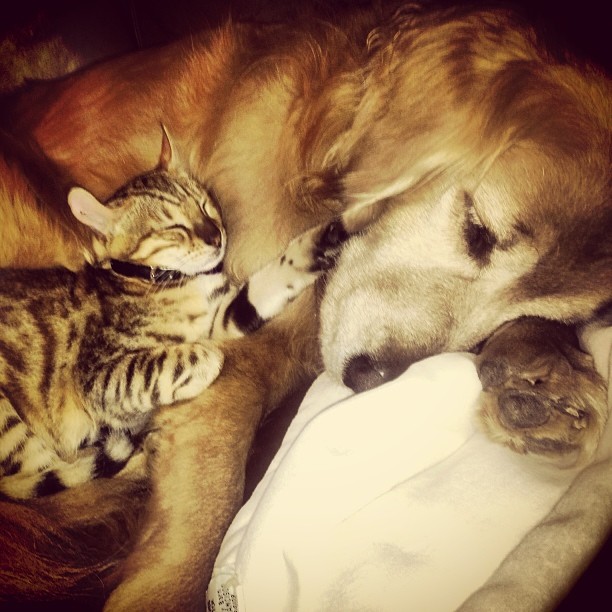
However, things weren't always so harmonious. Daisy has a pretty high prey drive for small , fast moving animals, aka kittens, so introducing a new family member had to be done very slowly and carefully. The more time and patience you put into introducing your dogs to a new cat or vice versa, the more successful the outcome. When we brought Tiger our new kitten home, we kept her in our bedroom for about a week. For the first few days, I let Daisy and Taj get to know her scent just by playing with Tiger and then letting the dogs smell me. I did not let the dogs see her or be in the same room with her for about three days. I wanted to "newness" of Tiger being in the house to wear off and I wanted Tiger to feel comfortable in her new home without feeling like some big monsters were going to barrel into the room and chase her under the bed. The first three days were crucial for our bonding time so that she could learn to trust me. I also made sure to give the dogs plenty of normal attention and play time.
After three days of playing it cool, I decided to bring the dogs into the bedroom on-leash one by one. With Daisy on leash, I used a clicker and lots of small-sized, smelly treats to reward her every time that she decided to look at me instead of the kitten. Then I asked her to stay in a down and continued to reward her for keeping her attention on me. It's important to keep everyone calm during this process and to keep the leash very relaxed. I also don't recommend holding the kitten or cat because they will feel trapped and even more fearful of the dog. After a day or two of several of these types of sessions, I dropped the leash and clicked/treated way less. I only clicked/treated when Tiger would make sudden movements or would get really close to Daisy to check her out. Around day five, I would let both dogs in the room with us at a time and then by day six everyone was well acquainted. By the end of the week, the dogs were intrigued, but completely welcoming and relaxed around the new kitten. Tiger was also feeling much more comfortable in her new surroundings (and successfully using the litter box!) so I decided to let her explore the rest of the house. While Tiger was dashing around and checking out every corner of her new playground, I did a few trick and treat sessions with Daisy and Taj to keep their attention on me and create a positive association with the new kitty in the house. Daisy and Taj were familiar with our cat Bear, making the process a lot easier, so if you're introducing your dog to a new cat here are some more pointers...
1) Work with your dog on basic obedience commands before you bring home your new cat. Especially work on sit-stays, down-stays, leave-it, staying calm with distractions and keeping attention on you.
2) Create a safe space for your new kitty. Introduce your cat and dog slowly. Don't overwhelm either of them and make sure they have spaces to get away from each other. You can also use an exercise pen if you don't feel like you have enough control of your dog on a loose leash. Sit with your dog inside of the pen while clicking/treating for good attention on you, while your cat hangs out in the room.
3) Judge your dog's reactivity. If your dog is intensely staring at your cat, stiffly wagging his tail, has a tense body and will not give you any attention while you call his name or make the kissy noise, your dog is still in a high prey drive mode and not ready to freely interact with your cat. If your dog can relax in the presence of the cat- low wagging tail, comfortably lying down, soft eyes, soft ears and able to give you attention at anytime- you may be able to move onto the next step of dropping the leash. Just go slow and do what you feel most comfortable with. If your dog has a severe prey drive, you may second guess bringing a cat into your home, or be willing to work really hard with attention clicker/treating exercises.
4) Use baby gates in your home to block off a room or two so that if your dog does try to chase your cat at some point, the kitty can jump the gates to safety. Also, make sure that your cat's food is up high and that your cat can't get to your dog's food or bother him while he's eating.
5) Give your dog lots of love, attention, exercise and play time even though you may be excited about hanging out with your new kitty. Dogs can get jealous and feel left out.
We've had Tiger as part of our family now for almost three months and we couldn't be happier with how well everyone is getting along. Even Bear, our older cat loves her and they chase each other around the house all day long. They stop for several cat naps and then they're at it again. To see Tiger cuddled up with Daisy just gets me every time. I've always considered myself a dog girl, but now I'm definitely a crazy cat lady too!
A collar and leash on a dog seems so natural and most people wouldn't think twice about just throwing a collar on a puppy and pulling them out the door on a leash. However, it's important to remember that a collar and leash is far from natural for a dog to wear. Take both of your hands right now and tighten it around your neck, then try to push your head forward against your hands as if pulling against a leash. Notice how a little panic starts to set in when you feel like you can't breathe. Next, put a rope around your neck, or if you're really brave, a metal prong collar and a leash. Then ask a friend to lead you around wherever she wants to go. Next, walk past a bear that's on the loose, or better yet someone who's running at you with a knife and try to pull away from the leash. Not fun to be scared and choked at the same time with no where to run, eh?

Some would say that I'm anthropomorphizing this scenario, but all I'm trying to do is put you in your dog's shoes, or paws, for a second. It makes me absolutely cringe to see people wildly yanking on leashes and dragging their dog around without proper cues or consistent directions.The key to a well behaved dog on a leash is to also be a well behaved human. Be consistent about which side you want your dog to walk on, hold the leash at the same length for walking in a heel position and let the leash out to the end when releasing your dog for a sniff and pee break. Teach your dog the heel command without a leash in your home at first by leading him around with a treat held by your side. Then introduce the leash in your home and each and every time your dog pulls, come a dead stop and wait till your dog takes the tension off and then move forward. Once your dog is understanding the concept of a loose leash and the heel command, start working outside with the same consistency and patience. Teach your dog to follow you by switching directions often. Teach your dog to give you attention when he is startled by a stimulus or when he is nervous around other dogs. Use the kissy noise, or a cue like "this way" when you want to switch directions or "wait" when you want to come to a stop.
Whatever you do, avoid a never ending game of tug-of-war and if you don't want your dog to pull on the leash, show him the same respect by not pulling on him. Think of the leash merely as a safety device, in fact, just wrap it around your waist if the habit to pull is so deeply engrained. Imagine in your head an invisible loose leash and use your signals with your voice, hands and body to convey that there is an invisible wall that extends from your side that your dog must not cross. Leave your phone at home or in your pocket when you take your dog for a walk. Majority of dogs, will take advantage of their human being distracted and will pull or lunge like crazy when their human is talking on the phone. It may take a long time to break the habit of pulling, but the proper tools, a lot of patience and a lot of understanding will have you well on the way to enjoying walks with your best friend again. We're here for you if you'd like to learn how to make walks fun again!
1 cute puppy 2 cups of love 5 cups of patience 1 Easy Walk Training Harness by Premier 6 ft Hands free leash 1 treat pouch 1 clicker 1/2 cup of soft smelly treats (cheese, chopped chicken, soft jerky treats, Zukes Mini Naturals or Ziwi Peak)
Directions:
1. Before you even clip on the leash or step outside, make sure that your puppy knows what heel means (also make sure that you know what it means!). A lot of dogs and their humans think that it means jerk on the leash and say heel whenever your puppy pulls. This only results in tug of war, frustration and a choking dog. Heel means that your puppy must stay by your side with his head lined up by your leg and his body parallel to yours. When your inside your house with no distractions lure your puppy to your side with a treat and click and feed once he is in the right position. Keep reinforcing your puppy for staying by your side in a standing position by clicking/treating. Then next step is to take a step forward and encourage your puppy to take a step forward with you. Keep your hand with the treat on the seam of your pants and when your puppy’s head is by your side click/treat. Keep doing this until you’re able to take several steps with your puppy walking right next to your side. Then take the lure away by guiding your puppy with your hand and without the treat in it. Click/treat when his head is by your side and then reach your hand into to your pouch to give him his reward.
2. Once your puppy is happily heeling by your side in the house you can attach your hands-free leash to your waist and to your dog’s front connecting harness. Ask him to sit and stay at the door and then release him with “ok!” once the door is all the way open. If his bottom pops up, close the door and repeat until he’s able to stay calmly as you open the door. Once you get outside the door ask him to sit calmly again. Ask your puppy to “look” and click/treat him for giving you attention. Then release him with an “ok, heel!” and walk off quickly in the direction you want to go.
3. When walking your puppy, pretend like you are the Queen (or King) of dogs and walk as quickly as you can. When dogs are in a trotting pace, they know that you mean business and that you’re traveling somewhere together. If you walk slowly, your dog will want to do a lot more sniffing which results in more pulling. Plus, your dog will think you’re more fun if you’re walking quickly and happily. Also, leave your phone at home! If you’re not paying attention to your puppy he will ignore you too and will want to drag you to every bush in the neighborhood to check his pee-mail.
4. Just like in the house, capture and reinforce your puppy’s good behavior with lots of “good heel!” and click/treats. Remember to feed right by your side near the seam of your pants. When distractions come your way, click/treat more quickly.
5. If your puppy pulls you or ignores you due to distractions, ask him to “look” or use the kissy noise to get his attention back to you. if he ignores you after two tries, quickly turn and go the other way. It will keep him on his toes and ‘reset’ the heel. If your dog lunges or pulls for something, you can also stop dead in your tracks and ‘be a tree’ until your dog calms down, stops pulling and takes the tension off his lead. A tight leash means your puppy goes nowhere and doesn’t get to check out whatever he wants to move towards. A loose leash is good and means that he gets to go towards what he wants to check out. Moving forward is a reward. Pulling equals stopping which is the consequence.
6. Be consistent and your puppy will be walking beautifully by your side in no time! Once he knows what “heel” means you can start weaning him off the treats and just use lots of praise and attention when he’s traveling by your side. Also, remember to reward your dog with “ok go ahead!” Which means he’s allowed to go out on the end of his leash and sniff and smell all the flowers and bushes that his heart desires!
Below is a quick clip of a training session with Lego today! Lego is a 4 month old adorable shepherd/lab mix puppy who is learning how to walk on a loose lead and walk nicely with distractions. This is his first time learning the heel command, therefore we are using lots of repetition and treats, but gradually we phase out the clicker and the treats to replace it with life rewards and praise. For instance, the reason why dogs want to pull is because they want to sniff and smell. So you can reward them by releasing them from your side with a "Ok! Go ahead" and allow them to go to the end of the leash to sniff, smell, explore and be a dog. They still shouldn't pull you so if your dog does, 'be a tree' and do not move until they loosen the tension on the lead and give you attention.
Lego's first leash lesson (click on the lick for a quick video demo)
Happy training!




